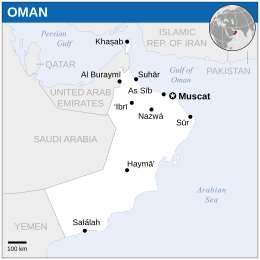More languages
More actions
| Sultanate of Oman سلطنة عُمان | |
|---|---|
 | |
| Capital and largest city | Muscat |
| Official languages | Arabic |
| Demonym(s) | Omani |
| Dominant mode of production | Capitalism |
| Government | Unitary Islamic absolute monarchy |
• Sultan | Haitham bin Tariq |
• Crown Prince | Theyazin bin Haitham |
| Area | |
• Total | 309,500 km² |
| Population | |
• 2021 estimate | 4,520,471 |
Oman, officially the Sultanate of Oman, is a bourgeois monarchist state located on the Arabian Peninsula in Western Asia. Bounded by the Arabian Sea to its east, it borders Yemen, Saudi Arabia and the United Arab Emirates, as well as controlling two exclaves surrounded by the UAE close to the Strait of Hormuz.
History[edit | edit source]
Portuguese colonization[edit | edit source]
The Portuguese first appeared in the region in 1498 with the voyage of Vasco da Gama, and in the following decades they began occupying the region. Building on their empire in India centred around Goa, the Portuguese built up a string of coastal possessions in the Indian Ocean to function as its exclusive trade network. In tandem with their colonization of East Africa, the Portuguese took control of the wealthy Kingdom of Hormuz in 1515 having captured or destroyed all Omani coastal towns.[1]
By the early 17th century Portugal had begun to face pressure to its regional maritime hegemony from the British, Dutch and Ottomans. In 1624 the Ya’ariba dynasty came to power in the Imamate of Oman, traditionally the Omani interior, and began pressuring the Portuguese control over coastal Oman. Nasir bin Murshid and his successor Sultan bin Saif began taking control of forts across Oman and by 1650 Portugal was forced to abandon the last of its Omani possessions.[1]
The new Yarubid rulers set about consolidating their control and began a focus on furthering the interests of the merchant class, with an alliance forming between them and the ruling elite. The Omani, intent on expanding their regional influence, began wresting control of Portuguese East Africa away from the Europeans with help from reverse engineered Portuguese ships. Having successfully beaten back the retreating Portuguese the Omani essentially established their own empire having seized from the Portuguese the key settlements of Mombasa, Pemba, Zanzibar and Kilwa in modern day Tanzania.[1]
Sultanate of Muscat and Oman[edit | edit source]
After its 1962 nationalist revolution, Yemen supported the Popular Front for the Liberation of Oman, which led a rebellion in the Dhofar province of Oman. Saudi Arabia funded Oman to fight against the rebels.[2]
Sultanate of Oman[edit | edit source]
On July 23, 1970, to protect their interests, the British backed a coup against the unpopular reactionary government of Sultan Said bin Taimur, installing his son Qaboos bin Said as the new Sultan. Subsequently, at the end of 1970, Qaboos announced the creation of the Sultanate of Oman combining the Sultanate of Muscat and the Imamate of Oman.[3]
On September 29, 1971, Oman joined the Arab League, and on October 7, 1971, it also became a member of the UN.[3]
References[edit | edit source]
- ↑ 1.0 1.1 1.2 Jeremy Jones; Nicholas Ridout (2016). A History of Modern Oman: 'Oman and the Al Bu Said; Ya’ariba Expansion and Portuguese Power'. Cambridge University Press.
- ↑ Vijay Prashad (2008). The Darker Nations: A People's History of the Third World: 'Mecca' (p. 265). [PDF] The New Press. ISBN 9781595583420 [LG]
- ↑ 3.0 3.1 G. L. Bondarevskii (1979). The Great Soviet Encyclopedia: 'Oman; Historical survey'.


